13 April 2011 (posted the next day). It was a long, hard day today. I had wanted to get a really early start, but ended up not getting off until 7:45 am—though that wasn’t too long after sunrise. For the first 39 miles, I was heading due east along Interstate 10—the first half of that on a nice frontage road, the second half on the Interstate shoulder. There was supposed to be a strong tailwind all day and it started out that way, but then, inexplicably, the wind shifted to a modest headwind for about 20 miles. (The wind makes such a difference!)
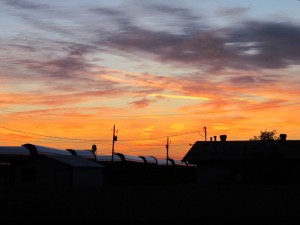
The train track runs right behind the Economy Inn, where I stayed. Here’s a passing train at sunrise. All the smoke in the air is making for some pretty skies!
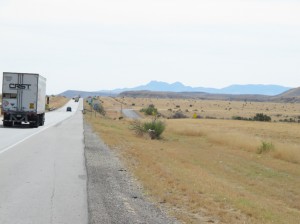
Wide shoulders, big trucks, and dodging tire puncturing bits of steel-belted radials on I-10. I was ready to leave the highway!
After I reached Kent, I turned south and followed Route 118, which passes through the Davis Mountains and up to the McDonald Observatory. That was another 39 miles, most of it uphill, with a climb of about 2,500 feet. Route 118 was gorgeous and almost totally free of traffic. I think only about 20 vehicles passed me all afternoon—one a nice couple who said they were also bicyclists and asked if I needed anything. I regretted for about ten miles not taking them up on that, at least for the chance to chat a bit!
With the turn south, the wind was mostly from the side (west), though I think it continued to be a net benefit to me, overall. There were plenty of times when I was pedaling into a headwind on the twisting road, but more of the time I had a tailwind. So I can’t complain about wind.

I passed this group of wild sheep that just didn’t look like Desert Bighorns; turns out they are Auodads or Barbary Sheep, from North Africa. They were introduced to West Texas at some point for sport hunting.
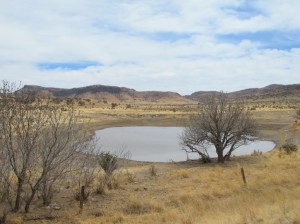
An unusual pothole pond along Route 118; there were dozens of ducks here, including blue-winged teal.

This almost looks like photos I’ve seen of the African savannas. I kept looking for excuses to stop and take photos!
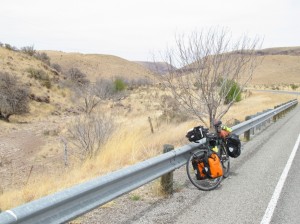
Another of those rest stops on Route 118. I’d look for a section of guardrail so that I could lean my bike against it—and sit down!
But the climb was hard for me. Relative to my original goal for the bike trip—time to quietly reflect on where green building needs to go, the focus of a writing project for the rest of my sabbatical, etc.—I find I’m not really doing that. I think more about my knees, the miles of covered, how many miles there are to go, how steep the next hill will be, and when I should take another dose of ibuprofen.
I’ve also heard that in getting over the Davis Mountains, I’ll have completed the most beautiful parts of this Southern Tier ride. So I’m at a decision point. Through yesterday, I’ve covered 1,100 miles in three weeks. I’m about 250 miles from Del Rio; I might put my bike (and self) on an Amtrak train there and head back to the real world.
So anyway, after 78 miles from Van Horn, I got to the McDonald Observatory and found John and Deb’
s house here.

As I rounded every bend in climbing up the mountains, I kept looking for the McDonald Observatory. Finally I was rewarded! Note the observatories on both peaks.
After a quick shower, Deb gave me a ride up to John’s office in the building housing the 107-inch Harlan J. Smith Telescope, which was built in 1966-68 and was the world’s third-largest telescope when completed (it’s now #39). John Kuehne is a computer whiz who keeps all of the software and control systems on that, and a much older telescope, working. With a Ph.D., he’s over-trained for the work, but a brilliant trouble-shooter. After finishing up a few things, he gave me a tour of both the 107-inch and 82-inch telescopes.
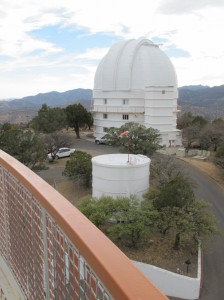
A view of the 82-inch, 1939 Otto Struve Telescope, the first one built here, taken from the catwalk on the 107-inch 1968 Harlan Smith Telescope

My WarmShowers host at his lab at the McDonald Observatory. That “block” on the lab desk is a malfunctioning motor controller—the heart of a telescope tracking system. He’s trying to troubleshoot it.
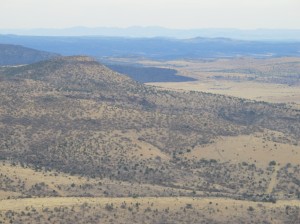
Looking out from the Smith Telescope catwalk at the burn from last weekend’s fire—which is still burning in some areas. That dark patch in the middle-distance came within a few hundred yards of a radio telescope located there (not part of the McDonald Observatory). In the far distance, the mountains are blackened by the fire.
When the older Otto Struve 82-inch telescope, completed in 1939, wasn’t tracking properly and nobody was doing anything about it (making it virtually unusable), he spent a couple weeks writing new code and getting it in better shape than ever. He’s now meticulously cleaning the brass teeth on the worm drive that moves the telescope. I watched him do that work for about an hour—though two thirds of that time was lengthy discourses on the history of theories about plate tectonics and how unwilling the geology establishment was to accept that radical new theory (from the 1930s until the 1970s, when it was finally accepted as settled science.) John’s Ph.D. is in geology.
We toured both the 107-inch and 82-inch telescopes and got into a length conversation with UT Austin professor Don Winget, who was calibrating the 82-inch scope in preparation for measurements of pulsars later that evening—if the cloud cover cleared sufficiently. We talked about an exciting pulsar (rapidly rotating neutron star) that he and John discovered recently—with a rotation frequency of just 12 minutes! Don showed me the screen captures showing the feature, though I wasn’t quite up-to-speed enough to follow precisely. John didn’t let me take flash photos in either of the two telescopes because scientists could be working on them, but Don let me do so in the 82-incher, since he was the scientist working on it that night.
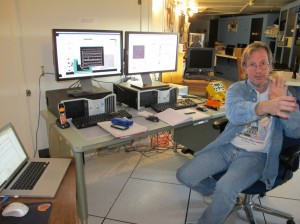
UT Austin professor Don Winget explains some of his work to a novice. He was incredibly generous of his time. Note his Macintosh laptop on the left.

The three of us sat around talking about everything from pulsars to the Hubble Space Telescope to green building for about 45 minutes.
We went in, turned on the lights, and he invited me to climb the steep stairs to look at it from the top—peering down into the mirror! I watched as the protective cover was opened. Then I got to use the joystick to adjust the altitude of the telescope to where it was needed for some calibration Don was carrying out. It was awesome. I have always wanted to visit an observatory, and I got the royal tour from these pros! Don has been teaching astronomy at UT Austin for 30 years and has been doing research all that time on the McDonald telescopes, coming here for a few days or weeks at a time.

Don repositioned the telescope so that we could climb up the steep stairs and look down into the mirror.
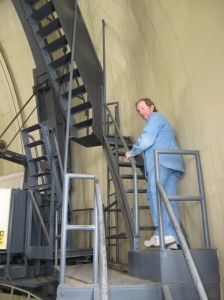
Following Don up the steep stairs. “Only hold the left handrail, as the right side swings out.” This wasn’t your standard tour!
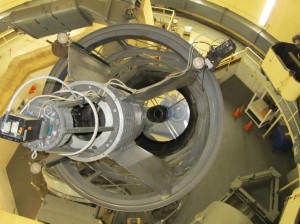
Now with the protective cover opened we’re looking at the actual mirror. The device at the tip holds the CCD, which captures the digital image—as in a digital camera.
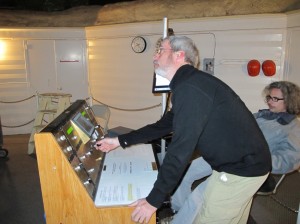
Here, under John’s watchful eyes, I’m using the joystick to reposition the telescope for calibration measurements Don needs to take.

By collecting exposures aimed at a white section of telescope housing (and out-of-focus) Don is able to identify dust particles, so they don’t get mistaken for celestial objects during his evening observations.
At one point we got into a conversation about the fixes that had to be made to the Hubbell Space Telescope. Both Don and John let out an audible sigh of disappointment about Hubble. Don said that any amateur astronomer who has made a telescope, as he did as a kid, knows about the knife-edge test (or something like that) that the experts making the Hubble overlooked. As a result a serious flaw dramatically reduced its effectiveness—though a fix was later added that recovered some of the lost resolution.
Don also noted that it was a case of politicians trying to decide how best to spend money on space exploration without asking astronomers. He said that for what was spent on Hubble, every professional astronomer in the world could have been given a 4-meter (160-inch) telescope! (I asked: there are about 4,000 astronomers, worldwide.)
John related a fascinating bit of history about the 107-inch Harlan Smith Telescope. Back in 1970 a disgruntled worker came in with a gun and ordered the telescope brought down to level. From his revolver, he fired six rounds at the glass mirror, hoping to shatter it. When that failed, he shifted to Plan B and walked into the telescope tube with a sledge hammer and wailed on the mirror. The foot-thick glass of the mirror was chipped a bit, but the net effect was reducing the effective aperture from 107 inches down to 106 inches. Apparently, because it’s a reflector telescope, a few imperfections have relatively little effect.

A last look at the 107-inch Harlan Smith Telescope in the ebbing light as we leave the observatory to head down to the house. I’ll visit the interior of this telescope tomorrow.

The sun was setting as we left the Observatory. I get the sense that John works long hours—and often comes back up in the evening to work with the scientists and do some research of his own. What an amazing tour!
We came down the hill to John’s house around 8 pm I think, stopping to take a few sunset photos from the top first and looking around at the areas where smoke was still rising from remaining fires in the area.
Tomorrow, I’m planning a rest day here at the McDonald Observatory. The predicted 40- to 50-mph winds are a factor in that decision, but I also want to rest up—and catch up on my writing/processing.
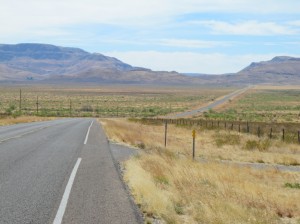
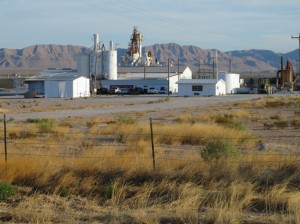
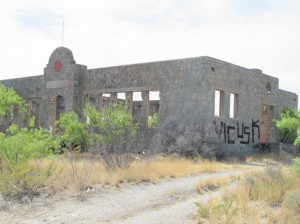




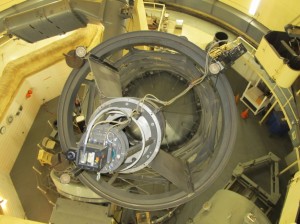

Amazing photos today, both of your travels and the Observatory…
That was a wonderful trip inside that observatory. Wow.
I can also relate to how when riding on a long distance trip, the details of life trump just about everything else. There can be a certain relaxation or letting go associated with it if it doesn’t rain too hard and there are no multiple flats! Totally enjoying your travels. Living the southern tier vicariously.
First off I want to say awesome blog! I had a quick question which I’d like
to ask if you do not mind. I was interested to know how you center yourself
and clear your thoughts prior to writing. I’ve had a
hard time clearing my thoughts in getting my ideas out there.
I truly do take pleasure in writing but it just seems like the first 10 to 15 minutes are generally
lost simply just trying to figure out how to begin. Any recommendations or hints?
Many thanks!